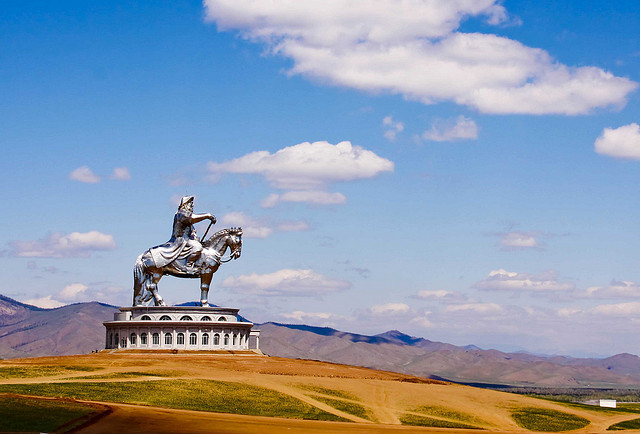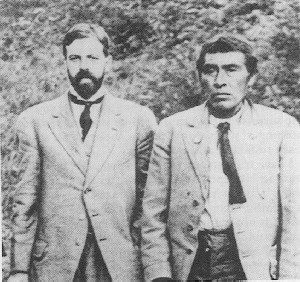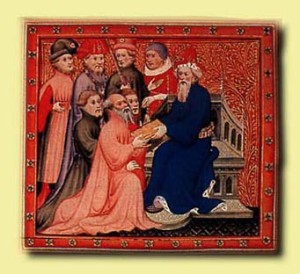

“Heredity”, opined the pioneering cultural anthropologist Alfred L. Kroeber in 1915, “cannot be allowed to have acted any part in history”. I have yet to encounter a crisper expression of the view that biological explanations have no place in the study of society and history. Kroeber’s words have resonated through the social sciences for a century, divorcing nurture from nature, social from biological, at considerable harm to our understanding of society and what it means to be human.
Fortunately, many 21st Century anthropologists, economists, neuroscientists, geneticists, sociologists and thinkers so busily inter-disciplinary that they defy dusty departmental labels, are consigning the hoary distinction between nature and nurture to the past. Likewise the distinction between heredity and history is steadily dissolving as the where intimate links between evolutionary fitness and major historic transitions come into view.
Last week’s European Journal of Human Genetics, for example, carried a fascinating article led by evolutionary geneticist Patricia Balaresque exploring the signature of historic population expansions in the distribution of Y-chromosome genotypes of men alive today.
The Y of who, what and when
The the human Y chromosome represents a tiny portion of the genome, including the genes that trigger a foetus to develop into a male, rather than following the default female pathway. Every now and then a small change occurs in one of the less important parts of a Y-chromosome’s DNA. Such a change is passed to a man’s sons, those sons’ sons, and so on. That means there’s quite a bit of variation in these Y-chromosome sequences in any human population.

So if a man happens to have many sons, who each go on to have many sons and so on, one might detect a sudden surge in the frequency of the Y-chromosome sequence borne by that line of men (patriline). In 2003, a large team from Oxford University detected evidence of just such an event. Across much of Asia, one particular Y-chromosome sequence was carried by 8 percent of all men. In a paper pithily titled “The Genetic Legacy of the Mongols”, they famously fingered Genghis Khan as the chief suspect.
The pattern of variation within the lineage suggested that it originated in Mongolia approximately 1,000 years ago. Such a rapid spread cannot have occurred by chance; it must have been a result of selection. The lineage is carried by likely male-line descendants of Genghis Khan, and we therefore propose that it has spread by a novel form of social selection resulting from their behavior.
Where by ‘behaviour’ they mean more than the Great Khan’s triumph in unifying the Mongols and establishing the largest continuous empire history has ever known. For Khan was as much about the establishment of a genetic dynasty as a political one. According to one disputed quote, he once said:
The greatest joy for a man is to defeat his enemies, to drive them before him, to take from them all they possess, to see those they love in tears, to ride their horses, and to hold their wives and daughters in his arms.
Or words to that effect.
Such a genetic legacy is far more than the work of a single man. It is likely that Khan’s uncles, brothers and cousins, played a substantial role, too. And his direct male descendants spread both his empire and his genetic legacy. Ghenghis’ grandson, Kublai Khan, married four main Empresses, but, according to Marco Polo’s Travels was attended to by hundreds of beautiful young women, working five at a time in three-day shifts. And a much greater number of women, recruited to the palace but, after a second round of screening, not deemed perfect enough for the Khan himself, were bestowed on Kublai’s nobles, many of whom would have been relatives sharing his patriline and Y-chromosome.
Khan not the only one
The Mongol expansion is far from the only such event to leave a genetic signature. A 2005 paper identified a particularly successful lineage that expanded about 500 years ago in Northeastern China, possibly through the lineage who established the Quing Dynasty.
Last week’s findings report on a survey of 5321 men from 127 Asian populations, testing for evidence of similar population expansions. Belaresque and her collaborators identified eleven such events, including the ones tied to the expansions of the Mongols and the Qing dynasty. And some of those events date back as far as 2100 BCE.
The earliest expansions, between 2100 and 300 BCE, are associated with the flourishing of agriculture in the Fertile Crescent, East India, and South East Asia. As agriculture took hold, elites accumulated wealth and influence beyond anything our hunter-gatherer ancestors could have conceived. These represent perfect conditions for sexual despots: male rulers who take many wives, keep numerous concubines or mistresses, and have many offspring. They also establish successions that favour their male descendants, handing them the wealth and power to become sexual despots themselves.
Another expansion began around 1100 CE in the Near East and expanded to the South East Indian coast. This might be a signature of the “rapid expansion of Muslim power … after the establishment of a unified polity in the Arabian peninsula by Muhammad in the 7th Century and under the subsequent Caliphates”.
The Mongol and Qing expansions, and another from Northeast China beginning no earlier than 850 CE, were not associated with the establishment and spread of agriculture, but rather with nomadic, pastoral lifestyles made possible by the domestication of horses. Pastoral nomads ruled the steppes for thousands of years, thanks to their horse-powered mobility and fighting ability.
They established several empires, giving rise to hierarchies, elites and patrilineal reproductive despots like the Khans and the Qing. And their Silk Road trade corridor facilitated westward expansion of their genetic dynasties.
Heredity and History
Even in the rather well-studied case of Genghis Khan we are well beyond certain idenfification of the individual progenitors whose success sparked each expansion. Innovative analyses and lucky ancient DNA finds may yet do so for some cases. But the ability to detect great tides of patrilineal descent in societies of various types offers far more interesting possibilities than compelling personal narrative.
The evidence shows that with great power and wealth can come great evolutionary fitness. The tools are now falling into place to assess how much the psychological adaptations that shape reproductive success have given history its shape.
This is one tale where History certainly represents HIS Story. The fact that new Y chromosome sequences can spread so fast and so wide when history’s tide turns suggests that a very small number of sexually despotic men can leave massive numbers of descendants. But each man who traces his descent back to Genghis Khan or another such super-ancestor through an unbroken male line has sisters who do so too, save for the very last branch in their family tree. If 2% of people in Asia descend on a male-only lineage from the same male ancestor as Khan, then how many times do they descend from him through at least one female ancesor?
Each of us descends many times over from a great many sexual despots. It would be Kroeber-like wilful ignorance to be think we don’t also inherit many of the genes that biased their behaviour toward the accumulation of power, the vanquishing of rivals and reproductive despotism.
And when I say “we”, I don’t only mean men. Every man has a mother. Every descendant of Ghenghis Khan is also a descendant of his mother Hoelun.
![]()
This article was originally published on The Conversation.
Read the original article.